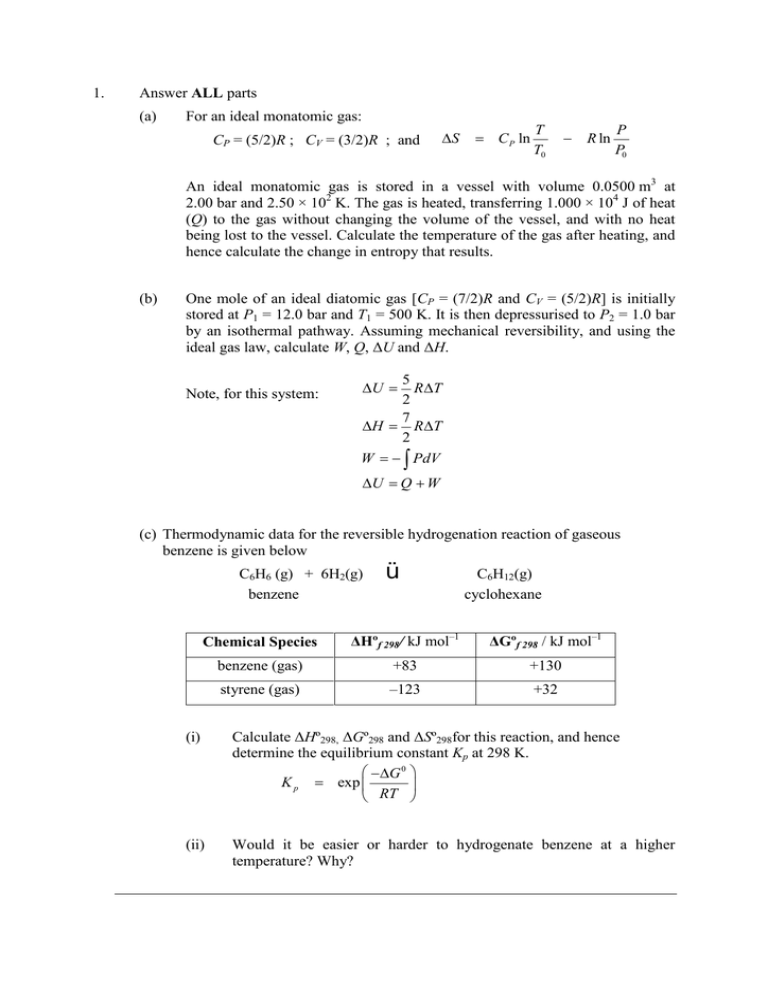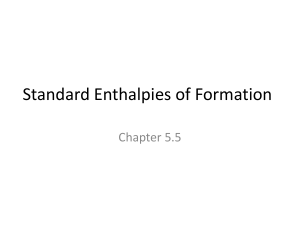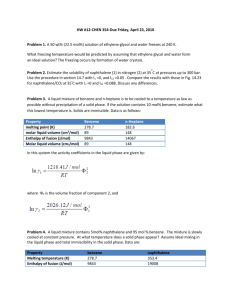1. ALL (a) For an ideal monatomic gas:
advertisement

1. Answer ALL parts (a) For an ideal monatomic gas: CP = (5/2)R ; CV = (3/2)R ; and S C P ln T T0 R ln P P0 An ideal monatomic gas is stored in a vessel with volume 0.0500 m3 at 2.00 bar and 2.50 × 102 K. The gas is heated, transferring 1.000 × 104 J of heat (Q) to the gas without changing the volume of the vessel, and with no heat being lost to the vessel. Calculate the temperature of the gas after heating, and hence calculate the change in entropy that results. (b) One mole of an ideal diatomic gas [CP = (7/2)R and CV = (5/2)R] is initially stored at P1 = 12.0 bar and T1 = 500 K. It is then depressurised to P2 = 1.0 bar by an isothermal pathway. Assuming mechanical reversibility, and using the ideal gas law, calculate W, Q, ΔU and ΔH. Note, for this system: 5 R T 2 7 H R T 2 W PdV U U Q W (c) Thermodynamic data for the reversible hydrogenation reaction of gaseous benzene is given below C6H6 (g) + 6H2(g) benzene C6H12(g) cyclohexane Chemical Species ΔHºf 298/ kJ mol–1 ΔGºf 298 / kJ mol–1 benzene (gas) +83 +130 styrene (gas) –123 +32 (i) Calculate ΔHº298, ΔGº298 and ΔSº298for this reaction, and hence determine the equilibrium constant Kp at 298 K. G 0 K p exp RT (ii) Would it be easier or harder to hydrogenate benzene at a higher temperature? Why? 2. Answer ALL parts. (a) Balance the following reaction and hence evaluate the standard enthalpy of reaction if the reaction is carried out at 500 ºC? C2H6 (g) + aO2 (g) → bCO2(g) + cH2O(g) The enthalpy change for this equation is H T01 C P0 dT R T0 T1 R H T00 The enthalpy of formations of these compounds at 298 K are compund C2H6(g) CO2(g) H2O(g) Hfo298 / kJ mol–1 -85 -394 -242 The heat capacity of each substance is well described by the equation C P0 R A DT 2 where the constants A and D are: A D / (105 K2) C2H6 3.438 -0.177 O2 3.639 -0.227 CO2 3.217 0.114 H2O 3.470 0.121 Chemical species Why is no value given for the enthalpy of formation of O2?





